
Declines of Specific Animal Species in Tropical Forests Affect Lowland Western Amazonian Tree Communities
Human hunting of large Amazon rain forest animals—such as spider monkeys, capuchin monkeys, tapirs and white-lipped peccaries, as well as some bird species such as guans and trumpeters—is having an impact on the spatial distribution of seeds needed to produce future generations of trees, a new study shows. Ultimately, this could affect the capacity of these forests to serve as “carbon sinks” that absorb global carbon dioxide emissions.
Amazon forests without native animals are different: defaunation—the elimination of native animals from ecological communities—has long-term, measurable consequences for tropical forest trees, researchers found. However, it is still not known whether these defaunated forests will lose their current ability to absorb enormous amounts of atmospheric carbon dioxide, and much more field data would be required to make such a determination.
Results of this research—conducted by a research fellow at San Diego Zoo Global, in collaboration with researchers at the University of Connecticut; Universidad Nacional San Antonio Abad Cusco, Peru; Duke University; and the Field Museum, Chicago—were published today (Feb. 15, 2018) in the Journal of Ecology, in an article titled “Defaunation Increases the Spatial Clustering of Lowland Amazonian Tree Communities.”
Large vertebrates make important contributions to the composition, structure and dynamics of plant communities, as seed dispersers. Tree species dispersed by large frugivorous animals generally sequester more carbon than species dispersed by other agents, such as wind, bats and small birds. Over two-thirds of species of woody plants in tropical forests rely on animals for seed dispersal, and large vertebrates are particularly effective dispersers because they consume large quantities of fruits and seeds—and they often pass the seeds through their digestive tract intact after transporting them large distances. Given the importance of interactions between large vertebrates and plants, the dramatic declines of large vertebrate populations in tropical forests worldwide are predicted to have major consequences for plant communities.
“What we found from analyzing our field data is contrary to some recent modelling studies,” stated Varun Swamy, Ph.D., research fellow, San Diego Zoo Global. “Defaunation is not going to automatically result in massive biomass losses, due to changes in tree species composition. Much more on-the-ground research is needed in order to fully understand the long-term fate of Amazon rain forests without key native fauna like spider monkeys, white-lipped peccaries and other large vertebrates.”
This is the first study to evaluate the impact of defaunation on tropical forests at the scale of a river basin, using field data from hundreds of tree species. The study examined spatial patterns of trees within six long-term forest plots in the Madre de Dios River basin in southeastern Peru. Sampling efforts involved tagging, mapping, measuring and identifying over 65,000 stems in approximately 60 acres (an area the size of 25 soccer fields), spread across 30,888 square miles (80,000 square kilometers) of lowland western Amazon rain forest.
“Our research confirms that defaunation sets into play significant and long-term spatial reorganization of Amazon tree communities,” stated Swamy. “Interestingly, this is history repeating itself, in a sense. Twelve thousand years ago, there were megafauna like gomphotheres and giant ground sloths crashing through these forests and significantly modifying the vegetation structure, until they were made extinct by the first human settlers of the Amazon. Although we can't bring back extinct megafauna and go back 12,000 years in time, it is vital that current and future conservation efforts and goals take into account the critical ecological roles of contemporary native vertebrates that have already been ecologically eliminated from many areas of standing tropical forest.”
Sites like Manu National Park and Cocha Cashu Biological Research Station, where this study was conducted, are critically important as baseline references for ecologically intact Amazon rain forest ecosystems. Baseline data from these sites allow scientists to understand the vital ecological roles played by native fauna and the impact of their elimination, and aid in planning ecological restoration of defaunated forests in the future. The forest around Cocha Cashu Biological Research Station is one of the most biodiverse lowland tropical forests in the world and is considered one of the most undisturbed terrestrial ecosystems on the planet. San Diego Zoo Global took over operation of this research station in 2011 and has invested enormous effort in supporting and stimulating long-term ecological research at the station. “We are pleased to support this kind of research out of Cocha Cashu, which today is one of the few places left where one can go to study nature as it should be,” said Ron Swaisgood, Ph.D., Brown endowed director of Recovery Ecology for San Diego Zoo Global and general scientific director of Cocha Cashu. “The station has established research goals that target important management questions that will inform management of the Park, and this research is an excellent example of what can be accomplished by studying pristine and disturbed areas in a comparative context.”
The paper—DOI: 10.1111/1365-2745.12929—is available online at http://onlinelibrary.wiley.com/doi/10.1111/1365-2745.12929/full.














